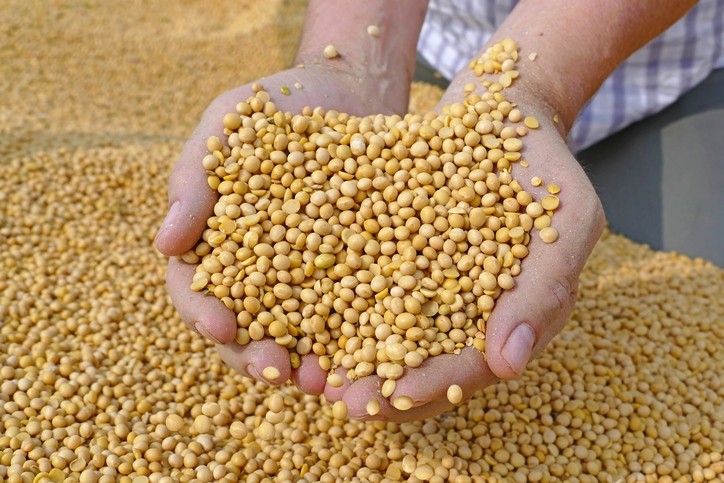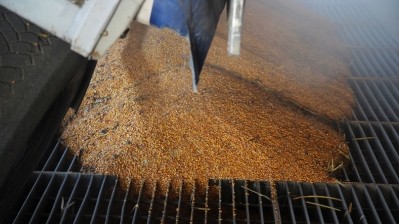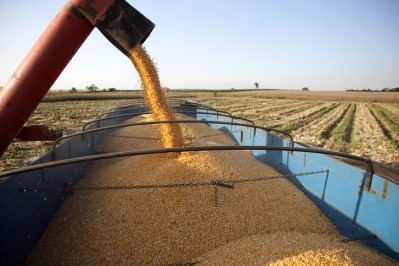USDA: Ending stocks of wheat, maize and soybeans all raised

The US Department of Agriculture (USDA) released details of US and global feed crop production earlier this week in its December World Agriculture Supply and Demand Estimate (WASDE) report.
Overall, the report brought few changes to the US picture, most, if any, related to corn, said Chad Hart, associate professor of economics, crop market specialist and extension economist at Iowa State University.
Use of the feed grain was lowered by about 50m bushels based on ethanol as the US market sees challenges from higher corn prices, low oil prices and low prices for dried distillers grains with solubles (DDGS).
“Looking at the [US corn] ending stocks – the number is higher than we had going into the report,” he told FeedNavigator. “It’s relatively lower looking back on the last few years [as] we’ve been able to bring those ending stocks down – but they’re still pretty sizable.”
Looking forward, the areas to watch are whether the overall size of the US crop will be reduced in January, he said.
On the demand side, the focus will be if there is any change to the export prediction for soybeans or ethanol.
In terms of US feed grain planting in the spring, the expectation is that about 6.6m acres will come out of soybeans, said Hart. Initial considerations from the USDA suggested that about 3m would go to corn and about 3m to wheat.
However, there is some thought that the split may see additional acres shift to corn, he said. “If I add that much additional acreage [in corn] 4 or 4.5m acres that creates a lot more bushels searching for a home,” he added.
“If we get that additional acreage – the USDA’s projections say [US] corn can handle some of the acres coming out of soybeans, but the market’s not built to handle the vast majority coming out of soybeans,” he said. “About 3m acres could be manageable, 4m is flat and 4.5m is building stocks and watching prices decline again.”
US planting decisions could tilt the price for corn back slightly, depending on how much is added in the coming production season, he said. A “fair amount” of acres have already been determined as efforts were taken to prepare fields for spring planting.
“The vast majority is already decided, but in early and mid-spring you have about 10% of land that could swing late in the game,” Hart said. Those changes would be based on weather conditions and speed of initial planting, he added.
“For soybeans, it’s a rebuilding year as we [US farmers]pull ourselves back to where we were in 2015 2016 in terms of acreage – corn is more like 2018 was a rough year and 2019 has the potential to look better,” he said. “Instead of starting the rebuilding process we’re halfway through and we’re starting to see some of the benefits.”
“For wheat the thought process is it just looks like they’re a step or two behind compared to corn,” he added.
“There could be some opportunities for farmers today to … do some risk management,” said Hart.
Looking at the corn futures market there could be some opportunities for producers to lock in prices in 2019 in case there is a large shift in corn acres, he added.
On the feed use side, this is the time of year when US feed costs can increase, he said. “I’d argue two pricing opportunities in early April right after the planting intentions report - that’s the first one - and the second one would be end of June or early July,” he added.
Soybean questions
Total oilseed production in the US for 2018/19 is predicted to be about 135.5m tons, a slight increase in the prediction stems from an increase in cottonseed, the USDA said.
US soybean production, use and exports were not changed from earlier predictions and ending stocks are anticipated to be about 955m bushels.
The season-average price range is set at $7.85 to $9.35 a bushel, the department said. The price range for soybean meal is $290 to $330 a short ton.
Although there were not many changes for US soybean production, Reuters reported a sale of more than 1.5m tons of soybeans US soybeans to China on Wednesday.
“Any sales to China right now are a major deal here,” Hart said. “What remains to be seen is if this is a one-off deal, or if we will see additional sales especially as we move forward.”
“When you look at the soybean market, China traditionally buys from the US from September to January,” he added. “The time period starting in February, that’s when South America starts to be the larger exporter – we’re getting toward the tail end of our traditional marketplace – I’ll be watching to see if this is a one-off sale while the truce is in place or if we see more sales.”
International production was increased based on expanded soybean production in Brazil and Nigeria. Brazil’s soybean production is projected up 1.5m tons to 122m, reflecting higher yields in the Center-West region where crops have benefitted from favorable weather conditions, said the USDA.
However, the growth is partially offset by drops in production of rapeseed in Australia and India.
Exports in 2018/19 are anticipated to grow by 0.7m tons based on increased exports from Brazil, the department said. However, Argentina, Canada and Paraguay are set to see reductions in exports in the same period stemming from challenges with Brazil’s large, competitive supply.
Corn perspective
The US outlook for 2018/19 forecasts that less corn will be used with drops in ethanol production and larger ending stocks, said the USDA.
Corn used in ethanol production fell from September to November compared to the prior year – for the first time since 2012.
The season-average corn price range was limited to $3.25 to $3.95 per bushel, the department said.
Demand continues to be strong for corn, said Hart. “What USDA is projecting for the 2019 [season] is fairly strong international demand for corn,” he said.
“In 2017 exports that was the second best year we’ve had and 2018 is on pace to be the third and 2019 could be the fourth,” he said. There also has been strong usage in several feed markets, he added.
“The livestock industry has been growing,” he said. “The weakest link in the corn demand chain right now is the ethanol industry with feed and livestock industry in the middle and exports have been a positive story.”
Globally, coarse grain production in 2018/19 was predicted to increase by 0.3m tons with a production hike in Ukraine, the EU and Thailand, more than offsetting reductions for South Africa and Canada.
EU corn production is higher reflecting a larger forecast for Romania. Ukraine corn production is raised based on harvest results to date, and if realized, this month’s yield forecast would surpass the previous record set during 2016/17 by nearly 20%, said the USDA.
South Africa corn production is lowered as dry planting conditions are expected to reduce area. Canada corn output is down on declines in both area and yield. Corn exports are raised for Ukraine, but lowered for Mexico.
Imports are raised for Vietnam, Canada, Japan, Iran, and Colombia, with partially offsetting reductions for Libya and Venezuela. Foreign corn ending stocks are higher than last month, mostly reflecting increases for the EU, Mexico, Vietnam, Ukraine, and Japan, that more than offset declines for Brazil, Canada, and South Africa.
Wheat forecast
The forecast for US wheat production in 2018/19 looks to a drop in exports and bump in ending supplies, said the USDA. Exports were reduced by about 25m bushels stemming from “historically low exports” for hard red winter wheat.
Ending stocks were increased to 974m bushels, which remains lower than those established last year, the department said. Season average farm price has been increased at the midpoint to a range of $5.05 to $5.25.
World 2018/19 wheat supplies are increased 0.8 million tons as additional Russian carrying stocks and a larger Canadian crop more than offset a reduction in Australian production.
Based on the updated ABARES estimate, Australia’s production is lowered by 500,000 tons to 17m. This would be the lowest Australian wheat output since 2007/08. Canada’s wheat production is raised 300,000 tons to 31.8m million, based on the latest estimate by Statistics Canada.
Projected global 2018/19 trade is lower, as reduced Australian, EU, and US exports are partly offset by higher Russian exports, which are increased 1.5m tons to 36.5m. Russia and other Black Sea suppliers continue to displace EU and US exports in several markets in the first half of 2018/19 but are expected to be less competitive in the second half based on reduced exportable supplies, according to WASDE.
Australia’s wheat exports are lowered 1m tons to 10.5 million as its export prices are expected to remain uncompetitive and more supplies are consumed domestically for feed, said the USDA. Global ending stocks are raised 1.4m tons to 268.1m, primarily on increases for the EU and the US but are 4% lower than last year’s record 279.9m.
“What we’re staring at are very substantial local supplies,” Hart said of comparing the decision to plant corn, wheat or soybeans. “It’s sort of the search for the best house in the bad neighborhood.”
Looking at corn or wheat planting, the thought is to find the best opportunity, he said. At this point, that appears to be corn.
The delayed harvest this autumn in corn and soybeans presented challenges for producers looking to plant winter wheat, he said. “Winter wheat didn’t capture the acres we thought it would, and that puts all the pressure on spring wheat,” he said. “Spring wheat is the smaller of the two – it’s harder for spring wheat to make up that much area.”












